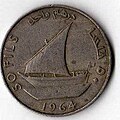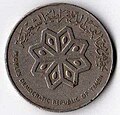South Yemeni dinar
| South Yemeni dinar | |
|---|---|
| Country: | South Arab Federation and Protectorate of South Arabia , from 1967 People's Democratic Republic of Yemen , from 1990 Yemen |
| Subdivision: | 1000 fils |
| ISO 4217 code : | YDD |
| Abbreviation: | £, د, YD |
|
Exchange rate : (March 1989) |
100 YDD = 519.0379 DM |
The South Yemeni Dinar or Yemen Dinar ( Arabic دينار يمني, DMG dīnār yamanī ) is a historical unit of currency that was in use in southern Yemen from 1965 to 1996. The currency was created on April 1, 1965 as the South Arab Dinar for the British Protectorate of South Arabia (so-called Eastern Protectorates) and the South Arab Federation (the so-called Western Protectorates with Aden ), which is also under British rule . After the founding of the People's Republic of Yemen in 1967, the currency continued to be used unchanged. In the first years after the unification of Yemen in 1990 , the dinar continued to circulate, especially in the southern parts of the country, and was only withdrawn as legal tender on June 11, 1996 .
prehistory
Aden was part of British India until 1937 and used the Indian currency; Even after the establishment of the Aden colony , the Indian rupee remained in circulation. After the Second World War, the British colonies in East Africa became the most important trading partner and in 1951 the East African shilling replaced the rupee as currency. In the remote sultanates of the mountainous hinterland, which as protectorates were only under indirect British rule, the Maria Theresa thaler and other silver coins were also used as a means of payment. In preparation for the independence of Aden and the surrounding protectorates, the South Arabian Currency Authority was founded in 1964 , which introduced the new dinar currency in 1965.
Banknotes and coins
The Yemen dinar was divided into 1,000 fils and introduced at a ratio of 1 dinar to 20 shillings. Since 20 East African shillings were equivalent to one pound sterling , there was exchange rate parity between the dinar and the pound.
Banknotes were originally issued in denominations of 250 fils, 500 fils, 1, 5 and 10 dinars, as well as coins of 1 (aluminum), 5 (bronze), 25 and 50 fils (each copper-nickel). The banknotes were produced by the De La Rue company . These banknotes and coins continued to be used unchanged after the independence of the People's Republic of Yemen on November 30, 1967. It was not until 1971 that the Arabic and English inscriptions on the coins were changed to Democratic Yemen , and in 1973 to the People's Democratic Republic of Yemen , and higher values of 100 and 250 fils were issued. A new series of banknotes, issued by the Bank of Yemen in Aden, appeared in 1984 and differed only slightly from the first series. However, the banknote for 250 fils was missing, as a coin for this denomination had meanwhile appeared.
After the unification of the two Yemen in May 1990, all cash holdings of the Bank of Yemen were transported from Aden to the Central Bank of Yemen in Sanaa and dispensed from there. The South Yemeni dinar remained in circulation as legal tender until June 1996 ; one dinar was worth 26 Yemeni rials .
Web links
- Monetary History of South Yemen , accessed January 12, 2011
- History of Yemeni Banknotes , accessed January 13, 2011
- Representation of the coins accessed on January 12, 2011
- Image of the banknotes ( Memento of March 4, 2007 in the Internet Archive ), accessed on January 13, 2011
Individual evidence
- ↑ Der Fischer Weltalmanach 1990, column 316, ISBN 3-596-19090-8



